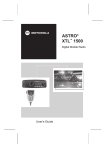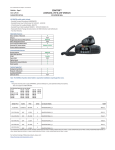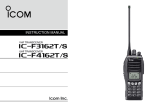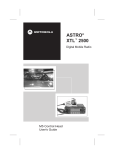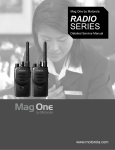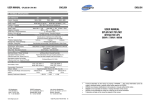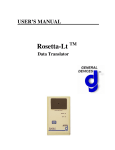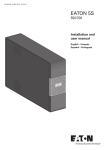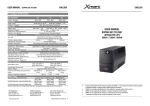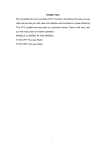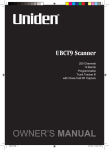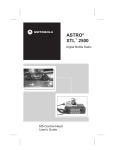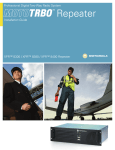Download PM1500 Users Manual
Transcript
PM1500 Control Head LED Indicators GCAI LCD Display Volume/Power Knob 4 Menu Buttons Emergency Button Mode Knob PM1500 User Guide Mobile Radio This declaration is applicable to your radio only if your radio is labeled with the FCC logo shown below. DECLARATION OF CONFORMITY Per FCC CFR 47 Part 2 Section 2.1077(a) Responsible Party Name: Motorola, Inc. Address: 8000 West Sunrise Boulevard Plantation, FL 33322 USA Phone Number: 1-888-567-7347 Hereby declares that the product: Model Name: PM1500 conforms to the following regulations: FCC Part 15, subpart B, section 15.107(a), 15.107(d) and section 15.109(a) Class B Digital Device As a personal computer peripheral, this device complies with Part 15 of the FCC Rules. Operation is subject to the following two conditions: 1. this device may not cause harmful interference, and 2. this device must accept any interference received, including interference that may cause undesired operation. Note: This equipment has been tested and found to comply with the limits for a Class B digital device, pursuant to part 15 of the FCC Rules. These limits are designed to provide reasonable protection against harmful interference in a residential installation. This equipment generates, uses and can radiate radio frequency energy and, if not installed and used in accordance with the instructions, may cause harmful interference to radio communications. However, there is no guarantee that interference will not occur in a particular installation. If this equipment does cause harmful interference to radio or television reception, which can be determined by turning the equipment off and on, the user is encouraged to try to correct the interference by one or more of the following measures: • Reorient or relocate the receiving antenna. • Increase the separation between the equipment and receiver. • Connect the equipment into an outlet on a circuit different from that to which the receiver is connected. • Consult the dealer or an experienced radio/TV technician for help. PM1500 Mobile Radio with Control Head ii Product Safety and RF Exposure Compliance ! Caution Before using this product, read the operating instructions for safe usage contained in the Product Safety and RF Exposure booklet enclosed with your radio. ATTENTION! This radio is restricted to occupational use only to satisfy FCC RF energy exposure requirements. Before using this product, read the RF energy awareness information and operating instructions in the Product Safety and RF Exposure booklet enclosed with your radio (Motorola Publication part number 6881095C99) to ensure compliance with RF energy exposure limits. Computer Software Copyrights The Motorola products described in this manual may include copyrighted Motorola computer programs stored in semiconductor memories or other media. Laws in the United States and other countries preserve for Motorola certain exclusive rights for copyrighted computer programs, including, but not limited to, the exclusive right to copy or reproduce in any form the copyrighted computer program. Accordingly, any copyrighted Motorola computer programs contained in the Motorola products described in this manual may not be copied, reproduced, modified, reverse-engineered, or distributed in any manner without the express written permission of Motorola. Furthermore, the purchase of Motorola products shall not be deemed to grant either directly or by implication, estoppel, or otherwise, any license under the copyrights, patents or patent applications of Motorola, except for the normal non-exclusive license to use that arises by operation of law in the sale of a product. Documentation Copyrights No duplication or distribution of this document or any portion thereof shall take place without the express written permission of Motorola. No part of this manual may be reproduced, distributed, or transmitted in any form or by any means, electronic or mechanical, for any purpose without the express written permission of Motorola. Disclaimer The information in this document is carefully examined, and is believed to be entirely reliable. However, no responsibility is assumed for inaccuracies. Furthermore, Motorola reserves the right to make changes to any products herein to improve readability, function, or design. Motorola does not assume any liability arising out of the applications or use of any product or circuit described herein; nor does it cover any license under its patent rights, nor the rights of others. MOTOROLA, the Stylized M Logo, and FLASHport are registered in the U.S. Patent & Trademark Office. All other product or service names are the property of their respective owners. © Motorola, Inc. 2006. Printed in the U.S.A. 03/06. iii Notations Used in This Manual Throughout the text in this publication, you will notice the use of WARNING, CAUTION, and Note notations. These notations are used to emphasize that safety hazards exist, and care that must be taken or observed. ! WARNING WARNING: An operational procedure, practice, or other condition, which might result in injury or death if not carefully observed. ! CAUTION CAUTION: An operational procedure, practice, or other condition, which might result in damage to the equipment if not carefully observed. Note: Note: An operational procedure, practice, or other condition, which is essential to emphasize. The following special notations identify certain items: Example Description Programmable button or > Buttons and keys are shown in bold print or as a key symbol. CALL Menu items (softkeys) are similar to the way they appear on the radio’s display. PM1500 Mobile Radio with Control Head iv Notes v Contents PM1500 Control Head . . . . . . . . . . . . . . . . . . . . . . . . . . i Declaration of Conformity .................................................................. ii Computer Software Copyrights .........................................................iii Documentation Copyrights ................................................................iii Disclaimer .........................................................................................iii Notations Used in This Manual ........................................................ iv Introduction . . . . . . . . . . . . . . . . . . . . . . . . . . . . . . . . . . 1 Using Your Radio: The Basics .......................................................... 1 Getting Started .................................................................................. 2 Major Radio Components ................................................................. 4 The PM1500 Radio ..................................................................... 4 The Control Head ....................................................................... 4 Operating Your Control Head ............................................................ 6 Turning On the Radio ............................................................... 6 Setting the Volume ................................................................... 7 Adjusting the Display/Keypad Backlight Dim Level .................... 7 Keypad Microphone Option ........................................................ 7 Conventional Channels .............................................................. 8 Field Programming ..................................................................... 8 Display Status ................................................................................... 8 Feature Control ................................................................................. 8 Interpreting Radio Status Indicators .................................................. 9 Status Annunciators ................................................................... 9 LED Indications ........................................................................ 10 Alert Tones ............................................................................... 10 Basic Operating Procedures . . . . . . . . . . . . . . . . . . . 13 Basic Functions ............................................................................... 13 Monitoring Conventional Modes ..................................................... 14 Selecting the Zone or Mode (Channel) ........................................... 15 Receiving on a Conventional Mode .......................................... 16 Adjusting the Squelch Level ............................................................ 16 Transmitting on Conventional Modes ....................................... 17 Time-Out Timer ........................................................................ 17 General Radio Features . . . . . . . . . . . . . . . . . . . . . . . 18 Often-Used Features ....................................................................... 18 Emergency Call and Alarm ............................................................. 19 Initiating an Emergency Alarm .................................................. 19 PM1500 Mobile Radio with Control Head vi Initiating an Emergency Call and Alarm ....................................20 Special Considerations for Emergencies ..................................20 Types of Scan ..................................................................................21 Types of Scan Lists ...................................................................21 Types of Scanning ....................................................................21 Turning Scan On or Off .............................................................22 Deleting Nuisance Modes .........................................................23 Hang Up Box (HUB) ..................................................................24 Optional External Alarms (Horn and Lights) ....................................24 Activating the External Alarm(s) ................................................24 Receiving a Call While Alarms Are Turned On .........................25 PTT-ID (For MDC and DTMF Modes only) ......................................26 Call Alert ..........................................................................................26 Sending a Call Alert .................................................................27 Conventional Radio Features . . . . . . . . . . . . . . . . . . 29 Features Used in Conventional Operation ......................................29 Smart PTT .......................................................................................30 Conventional Talkgroup Calls ..........................................................31 Conventional Talkaround .................................................................32 Talk Direct (Mobile-To-Mobile) ..................................................32 Selective Call ...................................................................................33 Answering a Selective Call .......................................................33 Initiating a Selective Call ...........................................................34 Viewing Your Unit ID Number ...................................................35 Editing a Unit ID Number in the List ..........................................35 Editing a Name in the List .........................................................36 Troubleshooting . . . . . . . . . . . . . . . . . . . . . . . . . . . . . 38 Accessories. . . . . . . . . . . . . . . . . . . . . . . . . . . . . . . . . 39 Antennas .........................................................................................39 Cables .............................................................................................40 Microphones ....................................................................................40 Miscellaneous ..................................................................................41 Speakers ..........................................................................................41 Trunnion Kits ....................................................................................41 vii Appendix: Maritime Radio Use in the VHF Frequency Range . . . . . . . . . . . . . . . . . . . . . . . . . . . . . . . . . . . . . . 42 Special Channel Assignments ......................................................... 42 Emergency Channel ................................................................. 42 Non-Commercial Call Channel ................................................. 43 Operating Frequency Requirements ............................................... 43 Glossary . . . . . . . . . . . . . . . . . . . . . . . . . . . . . . . . . . . . 46 Commercial Warranty and Service . . . . . . . . . . . . . . 49 Limited Warranty ............................................................................. 49 Service ............................................................................................ 53 Index . . . . . . . . . . . . . . . . . . . . . . . . . . . . . . . . . . . . . . . 55 PM1500 Mobile Radio with Control Head viii Notes ix Introduction Using Your Radio: The Basics This chapter gives you the basic knowledge you need in order to use your radio. The following topics are covered: • Getting Started (page 2) • Major Radio Components (page 4) • Operating Your Control Head (page 6) • Turning On the Radio (page 6) • Setting the Volume (page 7) • Turning the Display/Keypad Light On or Off (page 7) • Display Status (page 8) • Feature Control (page 8) • Interpreting Radio Status Indicators (page 9) PM1500 Mobile Radio with Control Head 1 Introduction Getting Started The PM™ 1500 Analog Mobile Radio is among the most sophisticated two-way radios available. It can operate in the following frequency ranges: VHF UHF 136-174 MHz 380-470 MHz These channels provide maximum communications capability under varying operating conditions. The PM1500 Mobile Radio can include an optional RS-232 data port to interface with external devices, such as certain laptop computers. 2 Introduction Note: In this manual— Your PM1500 Mobile Radio utilizes Motorola’s revolutionary FLASHport™ technology. This allows your radio’s capabilities to be flexible, because FLASHport makes it possible to add software that drives these capabilities both at the time of purchase and later on. Similar to how a computer can be loaded with different software, your radio’s features and capabilities can be upgraded with software. FLASHport allows you to add software to your radio as your needs change and as technology advances, making your radio investment go further. FLASHport is the future of radio communications, and it’s yet another example of Motorola’s commitment to your satisfaction. PM1500 Mobile Radio with Control Head 3 Introduction Major Radio Components Your radio has two major components: the radio unit installed in your vehicle and the control head that is used to activate various radio features. You may also have radio accessories installed based on the specific configuration of your radio. This user guide describes how to use your radio and its control head. The foldout page inside the back cover of this guide contains an illustration of the control head showing all the controls and programmable buttons situated on the control head. Keep this foldout open as a reference as you review the procedures in this user guide. The PM1500 Radio The PM1500 radio unit contains a receiver, a transmitter, and associated internal circuitry. The radio is programmed by your system manager to meet your specific needs and/or those of your workgroup. The Control Head The control head that came with your PM1500 radio has the following features (refer to the foldout at the back of this user guide): • Power On/Volume Knob: Used to turn the radio on or off and also to adjust the volume. • One-line, 8-character-per-line, liquid-crystal display (LCD): Shows alphanumeric messages or feature information as you use your radio. Also displays annunciators above the character lines, indicating the status of certain radio functions (see page 7). RESP EXIT • Mode Knob: Used to rotate through the list of available options, and also acts as a channel selector. 4 Introduction • Emergency Button: Programmed as the emergency button by default but can be custom programmed as any other feature. • LED indicator: Green/red/yellow light-emitting diode that indicates radio status as you operate various features (see page 9). • Four Programmable Menu Buttons: Check with your system manager for information on how these buttons have been programmed. Use the foldout at the back of this manual to record the functions that have been programmed to each button. • PTT button on mic: Pressed to transmit on the displayed mode and released to receive. PM1500 Mobile Radio with Control Head 5 Introduction Operating Your Control Head Your control head is designed for ease of use and flexibility of feature control. Before operating the radio, familiarize yourself with the various controls, indicators, and alert tones. Refer to the foldout diagrams in the front and back of this manual for your particular control head. Turning On the Radio Do the following: • To turn the radio on, push the Volume/Power knob on the control head to turn it on. After a short time, the red, green and yellow LEDs light up, indicating that the radio is powering up. The display then shows PM 1500. When the radio is fully powered on, the Zone and Channel text and menu items are displayed. The backlight will turn on to the last selected dim level. Note: Pressing the Power/Volume Knob before the LEDs light up will be ignored. Pressing the power button anytime after the LEDs light up will TURN OFF the radio. Note: If FL ##/## appears in the display, the radio will not function until the condition has been corrected. If ERR ##/## appears, some non-critical data has been changed. If either of these displays appear, if the display goes blank, or if the unit appears to be locked up, refer to the “Troubleshooting” section. 6 Introduction Setting the Volume Rotate the Volume knob clockwise to increase the volume and counterclockwise to decrease the volume. Adjusting the Display/Keypad Backlight Dim Level The display light is useful when you need to read the information on the display and locate keys on the keypad in less than optimal lighting conditions (for example, during night time). To adjust the display and keypad light: Press the DIM softkey, which is one of the four of the programmable menu buttons. The Control Head ships from the factory with the backlight set to HIGH. Keypad Microphone Option When accessing a feature on the radio, use the left or right toggles on the navigation key to access further options within the menu. If you cannot locate a menu item, it may not be programmed, or it may not apply to the radio’s current setting. The keypad also enables you to use certain capabilities within features such as Call Alert and Selective Call. These capabilities are described in detail within the appropriate sections of this manual. Note: The checkmark and X buttons on the keypad microphone are for future use and not currently used by the radio. PM1500 Mobile Radio with Control Head 7 Introduction Conventional Channels Conventional channels consist of a transmit and receive frequency pair, and associated squelch code pair, and a time-out timer value. See “Conventional Radio Features” on page 29. Field Programming Other radio features may be slaved to the selected mode by field programming. This mode slaving means that the radio is preprogrammed to automatically give you the proper operation for each mode you select. You may use the control head to program your own mode names. The names you assign are clearly shown in the alphanumeric display. You can see all the key operating information, including the mode selected or being scanned, and the on/off status of various features. The operating conditions are shown either by the display or by visual/ audio indicators, or by both. Display Status The control head display indicates your selected mode, or the currently active receive mode. Feature Control You can turn the various radio features on or off, change modes, and adjust the volume. To exit a feature, such as call, press the EXIT or HOME button located on the keypad mic. 8 Introduction Interpreting Radio Status Indicators Your radio has three types of status indicators: • Status annunciators that appear on the display • LED indicators • Alert tones Status Annunciators These are small icons that appear on the display above the channel name indicating status as you operate various radio features. Annunciator Indication C Carrier Squelch All active traffic on the selected channel in being monitored. When not displayed, traffic is not open to monitoring. F Call Received Flashes when a Selective Call, Call Alert is received. G Scan The radio is scanning a preprogrammed list of channels/modes for activity. H Priority Scan Indicates scanning of a priority mode (flashing for Priority 1 Mode; solid for Priority 2 mode). R Low Tx Power Level Transmission Power is low. (By default, the radio transmission power is set too high, at which state this icon will not show up.) J Direct/Talkaround When on, indicates your are talking directly to another radio. When off, you are talking through a repeater. PM1500 Mobile Radio with Control Head 9 Introduction Annunciator Indication K View/Program Mode The radio is in the view or program mode. (flashing for program mode; solid for view mode.) C In-Call User Alert Voice muting has been activated as radio is receiving. LED Indications The LED indicator on the front of the control head indicates operational status as you use various features: LED State Indication Continuous RED when you press PTT button to transmit Normal transmission YELLOW Channel activity is present GREEN Receiving a call or page Alert Tones Your radio uses alert tones to inform you of radio conditions. Tone Type Short, low pitched tone Indication Action Unsuccessful power-up. Radio failed self-test. Radio not ready for use. Contact your service representative. Invalid (bad) key press. A key - press was rejected. Time-out timer warning. Transmission time will expire in four seconds. 10 - Introduction Tone Type Indication Action Short, medium Valid (good) key press. A key pitched tone press was accepted. - Pressed emergency button to - enter emergency. Emergency entered. Short, high pitched tone Successful power-up. Radio Continuous, low pitched tone Transmit on receive-only mode. - passed self-test. Pressed PTT button on receive Release PTT button. only mode. Transmit inhibit on busy mode. Pressed PTT button while mode is busy Invalid mode. An invalid or - unprogrammed operation. Time-out timer timed out. Continuous, medium pitched tone Transmission terminated. Release PTT button. Emergency alarm/call exit. - Exiting. PM1500 Mobile Radio with Control Head 11 Introduction Tone Type Indication Action - Single, medium pitched tones followed by group of four medium pitched tones Your page has been received by Group of two medium pitched tones Selective Call received. - Group of four medium pitched tones every five seconds Call Alert (page) received by - Four short, medium pitched tones Emergency alarm Continuous, low pitched tone No Emergency. Current conventional system does not have emergency enabled. No emergency tone. - Group of two high pitched tones Fast ring in Selective call. - 12 the target radio. your radio. - acknowledged. System is searching for target radio. Basic Operating Procedures Basic Functions This chapter shows you how to access the radio’s basic functions and includes the following topics: • Monitoring Conventional Modes (page 14) • Selecting the Zone or Mode (page 15) • Receiving on Conventional Modes (page 16) • Adjusting Squelch Settings (page 16) • Selecting the Transmit Level (page 17) • Transmitting on Conventional Modes (page 17) PM1500 Mobile Radio with Control Head 13 Basic Operating Procedures Monitoring Conventional Modes To monitor conventional modes, do the following: 1 Press the preprogrammed Monitor button. 2 The display shows MON ON and the carrier squelch annunciator is turned on indicating that the squelch circuit has been opened, allowing you to monitor all the traffic on the channel. C MON ON To cancel monitoring 1 Press the preprogrammed Monitor button. 2 The display shows MON OFF and the carrier squelch annunciator is turned off. 14 MON OFF Basic Operating Procedures Selecting the Zone or Mode (Channel) A channel is a group of radio characteristics such as transmit/receive frequency pairs stored in your radio. A zone is a grouping of channels. A mode is a combination of zones and channels. Your radio is programmed by your system manager to have channels and zones that you need in order to perform your day-to-day operations. When your radio powers up, it defaults to the last selected zone and channel before it was powered off previously. At times, you may need to select a different zone or channel to transmit or receive on, as follows: 1 Press the D button below zone. 2 The display shows the current zone and mode. 3 Rotate the Mode Knob until the desired zone is displayed OR 4 Police 1 SCAN TGRP ZONE H/L Police 2 Police 1 Press ZNUP or ZNDN preprogrammed buttons or softkeys to scroll through the zones. OR 5 If you know the zone number, enter it using the keypad on the keypad mic. 6 Press the PTT button to begin transmitting on the displayed zone. 7 To select a particular mode within a zone, rotate the Mode Knob until the desired mode is displayed. Note: After the selection timer expires, the radio will automatically select the zone and mode. PM1500 Mobile Radio with Control Head 15 Basic Operating Procedures Receiving on a Conventional Mode Follow these steps to receive while on conventional mode: 1 Select a desired zone and mode. 2 When you hear a transmission, use the Volume Knob to adjust the volume to a comfortable listening level. Your radio is now set to receive on the selected mode. Note: If the mode is busy when your radio is receiving a clear signal, the yellow LED blinks continuously until the mode is not in use. Adjusting the Squelch Level Your radio’s ability to transmit or receive signals varies as you move away from or close to your base station. You can adjust your radio’s squelch to improve its ability to receive transmissions. Do the following: 1 Press SQL. The display shows SQL XX, where XX is a squelch level setting of 0 to 15. 2 To scroll to the desired squelch setting, choose on the following: Rotate the Mode Knob OR Press the + or - softkeys OR Use the navigation keys on the keypad mic. 3 16 Press the EXIT softkey to return to the selected channel. Basic Operating Procedures Transmitting on Conventional Modes Follow these steps to transmit while on a conventional mode: 1 Select a desired zone and mode. 2 When a mode becomes available, press and hold the PTT button to transmit. Speak clearly into the mic. Note: If you try to transmit on a receive-only mode, you will hear a continuous low-pitched (“invalid mode”) tone. Time-Out Timer This feature limits the amount of time you can continuously transmit. Your system manager can program the timer for up to 465 seconds at 15-second intervals. PM1500 radios are programmed at the factory to time-out after 60 seconds. Note: You hear a low-pitched alert tone four seconds before your transmission is about to expire. If you hold down the PTT button longer than the programmed time, you hear a continuous, low-pitched tone. This tone ceases to sound when you release the PTT button, and you are not allowed to transmit. PM1500 Mobile Radio with Control Head 17 General Radio Features Often-Used Features This chapter shows you how to access the most frequently used features. The following topics are covered: 18 • Emergency Call and Alarm (page 19) • Scan Operation (page 21) • Optional External Alarms (Horn and Lights) (page 24) • Push-To-Talk Identification (PTT-ID) (page 26) • Call Alert Page (page 26) General Radio Features Emergency Call and Alarm The emergency call and alarm features allow you to have priority channel access to the dispatcher in an emergency situation. The desired type of emergency feature—alarm, call, call and alarm — can be preprogrammed by a qualified radio technician. The radio must be turned on to activate any emergency feature. Initiating an Emergency Alarm The emergency alarm feature sends a data transmission to alert the dispatcher of your emergency condition and identify your unit ID. Press the emergency button. A tone sounds and the display alternates EMERGNCY with the current zone/channel. A dispatcher acknowledgment ACK RCVD display follows. The radio automatically returns to normal operation. No further action is required. PM1500 Mobile Radio with Control Head 19 General Radio Features Initiating an Emergency Call and Alarm If the radio has both emergency call and alarm features, it automatically proceeds to the call mode after the alarm is acknowledged. 1 Press the emergency button to activate the emergency call/ alarm feature. The display begins alternating EMERGNCY with the current zone/ channel. A dispatcher acknowledgment (four high-pitched tones) follows, accompanied by an ACK RCVD display. 2 Press the PTT button and announce your emergency. 3 To exit from the emergency state altogether, press and hold the emergency button until a tone sounds. The alternating EMERGNCY display disappears, and the radio returns to normal operation. Note: Turning the radio off also cancels the emergency state. Special Considerations for Emergencies • If you press the emergency button while in a mode that has no emergency capability, a low-pitched tone sounds. • If the emergency alarm is not acknowledged, a tone sounds and the display shows NO ACK. • If you press the emergency button, then change to a mode that has no emergency capability, a NO EMERG display alternates with the mode name display, and a continuous low-pitched tone sounds until a valid emergency mode is selected or until the emergency is cancelled. • When an emergency is active, changing to another mode where emergency is enabled causes an emergency alarm and/or emergency call to be active on the new mode. 20 General Radio Features Types of Scan Your PM1500 radio can monitor traffic on many different channels by scanning a list containing as many as 15 conventional or trunked modes. Up to 2 different scan lists are available per radio. A special package configured by your service provider can allow up to a maximum of 20 scan lists. Setting the modes to be scanned is programmed in advance by a qualified radio technician. Types of Scan Lists List Type Conventional Description Only conventional modes are in the list. Types of Scanning Scan Type Description Automatic (autoscan) When selected, a channel with autoscan automatically begins scanning its associated scan list. The radio continues auto scanning until you select a channel without autoscan enabled. Operator-Selectable Scan can be programmed, by a qualified radio technician, to be selected either from a menu or by a preprogrammed Scan button. Note: You cannot turn scan off on a mode that has autoscan enabled. Note: Scan lists stay in memory when you turn scan off, turn the radio off, or disconnect the radio from the battery. PM1500 Mobile Radio with Control Head 21 General Radio Features Turning Scan On or Off 1 Press button below SCAN. OR Police 1 SCAN Alternatively press the preprogrammed Scan button. 2 The display shows SCAN ON if previously SCAN OFF was selected and the scan indicator is turned on. SCAN ON OR 3 22 The display shows SCAN OFF if previously SCAN ON was selected and the scan indicator is turned on. SCAN OFF General Radio Features Deleting Nuisance Modes During scanning, you can temporarily delete modes you do not want to hear. This feature must be preprogrammed by your system manager. Follow these steps to delete a nuisance mode: 1 When the radio is locked onto the mode you want to delete, Press the preprogrammed Nuisance Delete button. OR Press the NUIS softkey to delete the mode. A valid key-press chirp tone sounds. The mode is deleted and the radio continues to scan the remaining modes Note: You cannot delete priority modes and the designated transmit channel. 2 To resume scanning the deleted mode, press scan off and then back on again. OR Turn the power off and then back on again. PM1500 Mobile Radio with Control Head 23 General Radio Features Hang Up Box (HUB) To temporarily suspend Scan Mode operation, remove the microphone from the Hang Up Box (HUB). You are allowed to use the microphone while scan is suspended. Priority Member scanning is not suspended, however. This feature applies to all Scan Lists and Scan Types. Scan is resumed once the microphone is returned to the holding clip and the preprogrammed hang time has elapsed. Note: Priority Scan List members are continuously scanned only when the Scan List, Designated Tx Member field is set to “Talkback” in the radio programming. Otherwise, all scan mode operation is suspended. Optional External Alarms (Horn and Lights) All control heads can be equipped for external alarms (horn and lights) that are activated when a Call Alert page or Selective Call, is received. These features are useful when you must leave the vehicle, but need to receive any incoming messages. The radio always powers up with the horn and lights feature enabled. Activating the External Alarm(s) Non-Permanent Horn and Lights 1 Press the H/L softkey momentarily. If necessary use theor buttons on the keypad mic to access other options within the menu. The last selected alarm(s) are enabled, and the display alternately shows the enabled alarm(s), then the selected mode. 2 24 Press the H/L softkey a second time to turn off the alarm(s). General Radio Features Receiving a Call While Alarms Are Turned On When a call is received, the vehicle’s horn sounds for four seconds, and/or the car lights turn on for 60 seconds. The time interval can be modified by a qualified radio technician. The display alternates between the type of call received (CALL or PAGE) and the selected mode name. Turning Off Non-Rearmable External Alarm 1 To turn off the external alarm(s), press the PTT button or any control-head button. Note: Pressing the CALL or PAGE softkey will turn off the external alarm(s) and place you directly in that feature. The Volume knob and the DIM button have no effect on the state of the external alarm(s). 2 To rearm the horn and lights feature, press the H/L softkey momentarily. Turning Off Rearmable External Alarms To turn off the external alarm(s), press the PTT button or any control head softkey or button other than the H/L softkey. Pressing CALL or PAGE softkey turns off the external alarm(s) and places you directly in that feature. When the external alarm(s) are turned off, they will be automatically rearmed. Note: Pressing the H/L softkey turns off the external alarm(s) and exits the horn and lights feature. To re-arm the feature, press the H/L softkey momentarily. The Volume knob and the DIM have no effect on the state of the external alarms. PM1500 Mobile Radio with Control Head 25 General Radio Features PTT-ID (For MDC and DTMF Modes only) This stands for Push-to-Talk ID. This feature is programmed as needed for each channel by your system manager. If this feature is made available for your talkgroup, it allows you to see the ID number of the radio from which you are receiving a transmission. This ID could be up to eight characters in length and is shown on your display as well as on your dispatcher’s display. In addition, your radio ID number is automatically sent when you transmit. Call Alert The Call Alert feature allows a radio to selectively alert another radio, and to determine whether or not that radio received the alert. A Call Alert page can be initiated, depending on the signaling (MDC, QCII or DTMF) that has been preprogrammed on the channel, after an unsuccessful Selective Call or as a separate feature. The PM1500 Controller Head is capable of responding to a Call Alert initiated by another radio. It features a unique list of up to 100 preprogrammed ID numbers. A name can be assigned to each ID in the list for your convenience. 26 General Radio Features Sending a Call Alert 1 Press the PAGE softkey. The Call Alert indicator lights and a valid-key chirp sounds. For MDC, the display shows the last transmitted/received unit ID number. For DTMF, it shows the last transmitted ID. For QCII, it shows the first entry in the call list. 2 Select a radio in one of the following ways: • From the ID number list: – Do nothing if you want to call the unit ID currently displayed. OR – Use the prestored list by using the mode knob or navigation keys on the keypad mic to locate the name/ID you want to call. OR – Enter, using the keypad on the keypad mic, the ID of the desired unit. Note: Using the keypad to enter the ID of another unit can only be accomplished from the first display shown when Page was entered. If the list has been entered, scroll to the first display. 3 Press the SEL softkey or the microphone PTT button. The display changes to PLS WAIT. PM1500 Mobile Radio with Control Head 27 General Radio Features 4 Choose one of the following: • When the called radio acknowledges the page, four additional tones sound and the display changes to ACK RCVD. The radio returns to normal operation. • If, after six seconds, the called unit fails to acknowledge the alert, a low-pitched tone sounds and the display changes to NO ACK. Try again by pressing the PTT button or the SEL softkey, OR Press the HOME button to exit. 28 Conventional Radio Features Features Used in Conventional Operation This chapter shows you how to access features available in conventional operation. The following topics are covered: • Smart PTT (page 30) • Conventional Talkgroup Calls (page 31) • Conventional Talkaround (page 32) • Selective Calls (page 33) 29 Conventional Radio Features Smart PTT Smart PTT is a per-mode feature that gives the system manager better control of radio operations. When smart PTT is enabled in your radio, you will not be able to transmit on an active mode. If you try to transmit (press the PTT button) on a busy or active smart PTT channel, a continuous tone sounds until you release the PTT button, and the transmission is inhibited. The yellow LED lights when the radio is receiving to indicate that the mode is busy. Three radio-wide variations of smart PTT can be enabled on your radio: Transmit Inhibit on Busy Mode with Carrier You will not be able to transmit if any activity is detected on the mode. Transmit Inhibit on Busy Mode with Wrong Squelch Code You will not be able to transmit on an active mode that has a squelch code other than your own. Quick-Key Override You can override either of the two previous transmit-inhibit states by quick-keying the radio (two quick PTT button presses). 30 Conventional Radio Features Conventional Talkgroup Calls The Talkgroup Select feature allows you to manually select any one of the available talkgroups. 1 Press the TGRP softkey. The display changes to show the last selected talk group. 2 Rotate the Mode Knob to choose a different talkgroup. 3 Press the SEL softkey to save the talkgroup. The radio returns to the home display. Note: To select the default talkgroup, press the SEL softkey while the radio displays PSET. Selecting the PSET softkey causes the radio to return to its preprogrammed talkgroup. To abort the talkgroup menu, press the HOME button or the PTT button: - Pressing the HOME exits the talkgroup select menu without saving the selected talkgroup choice. - Pressing the PTT button exits the menu without saving the selected talkgroup and allows the radio to transmit. Note: If the encryption key slaved to the new talkgroup is erased, the display shows KEY FAIL and a momentary tone is generated. If the encryption key that is slaved to the new talkgroup is not allowed, the display shows ILGL KEY and a momentary tone is generated. PM1500 Mobile Radio with Control Head 31 Conventional Radio Features Conventional Talkaround Talk Direct (Mobile-To-Mobile) To talk directly to another unit without going through the conventional repeater system: 1 Press the DIR softkey momentarily. The DIR indicator lights, indicating that the radio is now transmitting directly to another unit. 2 To return to repeater operation, press the DIR softkey again. The DIR indicator goes out. Note: A conventional personality can be configured to always transmit on the direct mobile-to-mobile frequency. In this case, the DIR indicator is lit continuously while the mode is selected. 32 Conventional Radio Features Selective Call The Selective Call feature not only allows you to carry on a conversation that is heard only by the two parties involved, but also enables you to determine whether the unit you are calling is in service. The PM1500 Control Head is capable of responding to a Selective Call initiated by another radio. It features a unique list of preprogrammed ID numbers. This depends on the signaling type (MDC, QCII or DTMF) that has been programmed on the channel. A name may be assigned to each ID in the list for your convenience. Answering a Selective Call When a Selective Call is received, two high-pitched tones sound and the display alternates between CALL RCV and the home display. 1 Press the CALL softkey within 20 seconds of receiving the call. (This time is programmable by a qualified radio technician.) The display shows the ID number of the calling unit. 2 To respond to the call, press the PTT button and talk. If 20 seconds pass before you press the CALL softkey, you will not respond privately to the call just received. Instead, when you press the CALL softkey, you enter the Selective Call state, as described in “Selective Call” on page 33. Note: If you do not press the CALL softkey before pressing the PTT button, your conversation will be heard by all members of the talk group. PM1500 Mobile Radio with Control Head 33 Conventional Radio Features Initiating a Selective Call To initiate a Selective Call, select a unit to call, then place the call. 1 Press the CALL softkey. 2 Select a unit in one of the following ways: • From the ID number list: – Do nothing if you want to call the unit ID currently displayed. OR – Use the prestored list by turning the Mode knob to locate the name/ID you want to call. OR – Enter, using the keypad on the keypad mic, the ID of the desired unit. Note: Using the keypad to enter the ID of another unit can only be accomplished from the first display shown when CALL was entered. If the list has been entered, scroll to the first display. Press the numeric keys on the keypad mic to enter the digit of the location number to access a preprogrammed call ID. 3 Press the microphone PTT button. A telephone-type ringing sounds if the unit you are calling is in service. 4 When the receiving unit answers, identify yourself and begin your Selective Call. 5 To return to normal operation, press the HOME button. Note: If you do not press the HOME button to hang up, your unit will remain in the Selective Call state with the other unit. You will miss all subfleet traffic. 34 Conventional Radio Features Viewing Your Unit ID Number 1 Press the CALL softkey momentarily to select the Selective Call feature. 2 Do one of the following: • Use the left navigation key on the keypad mic or the Mode Knob to locate the MY ID display. OR • 3 The display will alternate between MY ID and your ID number. To return to normal operation, press the HOME button. Editing a Unit ID Number in the List The Selective and Call Alert page features share the same prestored list of units’ IDs. 1 Press and hold the CALL softkey to review the Call ID list. 2 Use the navigation keys to locate the list member you want to change. 3 Press the NUM softkey to edit a number. 4 Use the keypad mic to update the entry. 5 When all the digits are entered, press the SAVE softkey to store the new ID. PM1500 Mobile Radio with Control Head 35 Conventional Radio Features 6 Repeat steps 2 through 5 until all the desired IDs have been entered. OR Do one of the following: • Press the HOME button to return to normal radio operation. OR • Press PTT to exit the feature. Note: The maximum number of characters permitted in a text line is 8. Editing a Name in the List The Selective Call and Call Alert page features share the same prestored list of unit IDs. 1 Press and hold the CALL or PAGE softkey to enter the Call ID list. 2 Use the navigation keys on the keypad mic or the Mode Knob to locate the list member you want to change. OR Use the numbered keys to go immediately to the location of a member in the list. For example, press 2 to go to the second member in the list; press 1 and 0 to go to the tenth member in the list, and so on. 3 Press the NAME softkey to edit a name. 4 Change the characters or numbers using any of the numeric keys (0 through 9) and special function keys (*, #) with the keypad mic. 36 Conventional Radio Features Note: The maximum number of characters permitted in a text line is 8. If you try to add too many characters, you will hear a low-pitched tone. To edit, do any or all of the following: • Press the key of the desired character the number of times shown in the table. For example, to enter the character C, press the 2 key three times. • To leave a space in the text, press the up navigation key on the keypad mic to move the blinking cursor to the next character position, and then enter the next character. • To delete characters, press the down navigation key to move backwards over existing characters. When the last character on the display has been erased, press the down navigation key again to leave the nameedit mode, without making any changes, and begin the procedure again at step 2. 5 To save the changes, press and hold the SAVE softkey. 6 Repeat steps 2 through 5 until you have modified all the desired names. OR Do one of the following: • Press the HOME button to return to normal radio operation. OR • Press PTT to exit the feature. PM1500 Mobile Radio with Control Head 37 Troubleshooting The following are suggestions to assist you in troubleshooting possible operating problems. ! CAUTION The cables that connect to the rear of the radio could have live voltage on some of their pins. Do not remove or reconnect these cables. Only a qualified radio technician should perform this task. Service performed by unauthorized personnel may cause the radio to transmit an emergency alarm even if the unit is turned off. If your radio is locked up or the display shows FL 01/90, turn the radio off and then back on. If this does not correct the condition, take the radio to a qualified radio technician for service. If radio operation is intermittent, check with other persons using the system for similar problems before taking the radio in for service. If symptoms persist or, if your unit exhibits other problems, contact a qualified radio technician. 38 PM1500 Mobile Radio with Control Head Accessories Motorola provides the following approved accessories to improve the productivity of your PM1500 mobile two-way radio. For a list of Motorola-approved antennas, batteries, and other accessories, visit the following web site: http://www.motorola.com/governmentandenterprise Antennas Part No. Description HAD4006_ VHF, 136–144 MHz, quarterwave whip, roof mount HAD4007_ VHF, 144–150.8 MHz, quarterwave, roof mount HAD4008_ VHF, 150.8–162 MHz, quarterwave, roof mount HAD4009_ VHF, 162–174 MHz, quarterwave, roof mount HAD4017_ VHF, 146-174 MHz, quarterwave RAD4010_ VHF, 136–174 MHz, halfwave, roof mount HAE4003_ UHF, 450–470 MHz, quarterwave whip HAE4011_ UHF, 450–470 MHz, 3.5 db, roof mount HAE6010_ UHF, 380–433 MHz, 3.5 db gain HAE6012_ UHF, 380–433 MHz, quarterwave whip HAE6013_ UHF, 380–470 MHz, 2.0 db gain, wideband RAE4014_RB UHF, 450–470 MHz, 5.0 db 39 Accessories Cables Part No. Description HKN4192_ Power, 20-ft., remote-mount HKN6188_ Control head power cable (includes ignition sense) HKN6164_ Remote Mount Cable (CAN) - 40m (131 ft) HKN6165_ Remote Mount Cable (CAN) - 35m (115 ft) HKN6166_ Remote Mount Cable (CAN) - 23m (75 ft) HKN6167_ Remote Mount Cable (CAN) - 15m (50 ft) HKN6168_ Remote Mount Cable (CAN) - 10m (30 ft) HKN6169_ Remote Mount Cable (CAN) - 5m (17 ft) HKN6170_ Remote Mount Cable (CAN) - 3m (10 ft) HKN6183_ Cable, CH Programming (RS-232) Microphones 40 Part No. Description HMN1090_ Standard Mic HMN4079_ Keypad Mic HMN1089_ Water Resistant Mic HLN1457_ Handset w/Hang up Accessories Miscellaneous Part No. Description GKN6271_ Ignition Sense Cable GLN7278_ PTT Footswitch HKN4258_ External Alarm Cable HMN1087_ Gooseneck PTT HLN5113_ Emergency footswitch HLN5131_ Emergency pushbutton switch HLN6953_ Buzzer Kit 110 MA TLN4533_ External Alarm Relay Speakers Part No. Description HSN4038_ 7.5 W external HSN4039_ 13 W external Trunnion Kits Part No. Description HLN6909_ Quick-release, high-power HLN6910_ Standard high-power HKN6186_ Trunnion, CH Remote Mount PM1500 Mobile Radio with Control Head 41 Appendix: Maritime Radio Use in the VHF Frequency Range Special Channel Assignments Emergency Channel If you are in imminent and grave danger at sea and require emergency assistance, use VHF Channel 16 to send a distress call to nearby vessels and the United States Coast Guard. Transmit the following information, in this order: 1 “MAYDAY, MAYDAY, MAYDAY.” 2 “THIS IS _____________________, CALL SIGN __________.” State the name of the vessel in distress 3 times, followed by the call sign or other identification of the vessel, stated 3 times. 3 Repeat “MAYDAY” and the name of the vessel. 4 “WE ARE LOCATED AT _______________________.” State the position of the vessel in distress, using any information that will help responders to locate you, e.g.: • latitude and longitude • bearing (state whether you are using true or magnetic north) • distance to a well-known landmark • vessel course, speed or destination 5 State the nature of the distress. 6 Specify what kind of assistance you need. 7 State the number of persons on board and the number needing medical attention, if any. 8 Mention any other information that would be helpful to responders, such as type of vessel, vessel length and/or tonnage, hull color, etc. 9 “OVER.” 10 Wait for a response. 11 If you do not receive an immediate response, remain by the radio and repeat the transmission at intervals until you receive a response. Be prepared to follow any instructions given to you. 42 PM1500 Mobile Radio with Control Head Appendix: Maritime Radio Use in the VHF Frequency Range Non-Commercial Call Channel For non-commercial transmissions, such as fishing reports, rendezvous arrangements, repair scheduling, or berthing information, use VHF Channel 9. Operating Frequency Requirements A radio designated for shipboard use must comply with Federal Communications Commission Rule Part 80 as follows: • on ships subject to Part II of Title III of the Communications Act, the radio must be capable of operating on the 156.800 MHz frequency • on ships subject to the Safety Convention, the radio must be capable of operating: • • in the simplex mode on the ship station transmitting frequencies specified in the 156.025–157.425 MHz frequency band, and in the semiduplex mode on the two frequency channels specified in the table below. Note: Simplex channels 3, 21, 23, 61, 64, 81, 82, and 83 cannot be lawfully used by the general public in US waters. Additional information about operating requirements in the Maritime Services can be obtained from the full text of FCC Rule Part 80 and from the US Coast Guard. Table A-1: VHF Marine Channel List Frequency (MHz) Channel Number Transmit Receive 1 156.050 160.650 2 156.100 160.700 * 156.150 160.750 4 156.200 160.800 5 156.250 160.850 6 156.300 – 7 156.350 160.950 PM1500 Mobile Radio with Control Head 43 Appendix: Maritime Radio Use in the VHF Frequency Range Table A-1: VHF Marine Channel List (Continued) 44 Frequency (MHz) Channel Number Transmit Receive 8 156.400 – 9 156.450 156.450 10 156.500 156.500 11 156.550 156.550 12 156.600 156.600 13** 156.650 156.650 14 156.700 156.700 15** 156.750 156.750 16 156.800 156.800 17** 156.850 156.850 18 156.900 161.500 19 156.950 161.550 20 157.000 161.600 * 157.050 161.650 22 157.100 161.700 * 157.150 161.750 24 157.200 161.800 25 157.250 161.850 26 157.300 161.900 27 157.350 161.950 28 157.400 162.000 60 156.025 160.625 * 156.075 160.675 62 156.125 160.725 63 156.175 160.775 * 156.225 160.825 65 156.275 160.875 66 156.325 160.925 Appendix: Maritime Radio Use in the VHF Frequency Range Table A-1: VHF Marine Channel List (Continued) Frequency (MHz) Channel Number Transmit Receive 67** 156.375 156.375 68 156.425 156.425 69 156.475 156.475 71 156.575 156.575 72 156.625 – 73 156.675 156.675 74 156.725 156.725 75 *** *** 76 *** *** 77** 156.875 – 78 156.925 161.525 79 156.975 161.575 80 157.025 161.625 * 157.075 161.675 * 157.125 161.725 * 157.175 161.775 84 157.225 161.825 85 157.275 161.875 86 157.325 161.925 87 157.375 161.975 88 157.425 162.025 * Simplex channels 3, 21, 23, 61, 64, 81, 82, and 83 cannot be lawfully used by the general public in US waters. ** Low power (1 W) only *** Guard band Note: A – in the Receive column indicates that the channel is transmit only. PM1500 Mobile Radio with Control Head 45 Glossary Glossary ACK Acknowledgment of communication. Call Alert A one-way alert, with audio and/or display messages. Channel A group of characteristics, such as transmit/ receive frequency pairs, radio parameters, and encryption encoding. Coded Squelch Tone Private-Line™ or Digital Private-Line. Used on conventional channels to make sure you hear only the communication meant for you. Conventional Typically refers to radio-to-radio communications, sometimes through a repeater. You share a frequency, or frequencies, with other users without the aid of a central controller to assign communication channels. Therefore, you should monitor each channel before transmitting to avoid interfering with another user who may be transmitting. Cursor A visual tracking marker (a blinking line) that indicates a location on the display. Digital PrivateLine (DPL) Coded Squelch A continuous, sub-audible data signal, transmitted with the carrier. Dispatcher An individual who has radio system management duties. FCC Federal Communications Commission. Hang Up Disconnect. 46 Glossary Home Display The first display information after the radio completes its self test. LCD Liquid-Crystal Display. Mode A programmed combination of operating parameters; for example, a channel or talkgroup. Mode-Slaving Radio programmed to automatically give the proper operation for a given mode you have selected. Monitoring (Conventional Operation) Press a programmed monitor button to listen to another user active on the channel. This way, you may be prevented from talking over someone else’s conversation. Push-To-Talk (PTT) button The PTT button engages the transmitter and puts the radio in transmit (send) operation when pressed. Press this button to transmit; release it to receive. Repeater A conventional radio feature, in which you talk through a receive/transmit facility (repeater) that re-transmits received signals in order to improve communications range and coverage. RF Radio Frequency. A part of the general frequency spectrum between the audio and infrared light regions (about 10 kHz to 10,000,000 MHz). Squelch The muting of audio circuits when received signal levels fall below a pre-determined threshold. With carrier squelch, you hear all channel activity which exceeds the radio’s preset squelch level. PM1500 Mobile Radio with Control Head 47 Glossary Talkgroup An organization (or group) of radio users who communicate with each other, using the same communication path. Tone Private-Line (PL) Coded Squelch A continuous sub-audible tone transmitted with the carrier. Zone A grouping of channels or talkgroups. 48 Commercial Warranty and Service Limited Warranty MOTOROLA COMMUNICATION PRODUCTS I. WHAT THIS WARRANTY COVERS AND FOR HOW LONG: MOTOROLA INC. (“MOTOROLA”) warrants the MOTOROLA manufactured Communication Products listed below (“Product”) against defects in material and workmanship under normal use and service for a period of time from the date of purchase as scheduled below: CHIEF PM 1500 Mobile Units Two (2) Year Product Accessories One (1) Year Motorola, at its option, will at no charge either repair the Product (with new or reconditioned parts), replace it (with a new or reconditioned Product), or refund the purchase price of the Product during the warranty period provided it is returned in accordance with the terms of this warranty. Replaced parts or boards are warranted for the balance of the original applicable warranty period. All replaced parts of Product shall become the property of MOTOROLA. This express limited warranty is extended by MOTOROLA to the original end user purchaser only and is not assignable or transferable to any other party. This is the complete warranty for the Product manufactured by MOTOROLA. MOTOROLA assumes no obligations or liability for additions or modifications to this warranty unless made in writing and signed by an officer of MOTOROLA. Unless made in a separate agreement between MOTOROLA and the original end user purchaser, MOTOROLA does not warrant the installation, maintenance or service of the Product. MOTOROLA cannot be responsible in any way for any ancillary equipment not furnished by MOTOROLA which is attached to or used in connection with the Product, or for operation of the Product with any ancillary equipment, and all such equipment is expressly excluded from this warranty. Because each system which may use the Product is unique, MOTOROLA disclaims liability for range, coverage, or operation of the system as a whole under this warranty. 49 Commercial Warranty and Service II. GENERAL PROVISIONS: This warranty sets forth the full extent of MOTOROLA'S responsibilities regarding the Product. Repair, replacement or refund of the purchase price, at MOTOROLA’s option, is the exclusive remedy. THIS WARRANTY IS GIVEN IN LIEU OF ALL OTHER EXPRESS WARRANTIES. IMPLIED WARRANTIES, INCLUDING WITHOUT LIMITATION, IMPLIED WARRANTIES OF MERCHANTABILITY AND FITNESS FOR A PARTICULAR PURPOSE, ARE LIMITED TO THE DURATION OF THIS LIMITED WARRANTY. IN NO EVENT SHALL MOTOROLA BE LIABLE FOR DAMAGES IN EXCESS OF THE PURCHASE PRICE OF THE PRODUCT, FOR ANY LOSS OF USE, LOSS OF TIME, INCONVENIENCE, COMMERCIAL LOSS, LOST PROFITS OR SAVINGS OR OTHER INCIDENTAL, SPECIAL OR CONSEQUENTIAL DAMAGES ARISING OUT OF THE USE OR INABILITY TO USE SUCH PRODUCT, TO THE FULL EXTENT SUCH MAY BE DISCLAIMED BY LAW. III. STATE LAW RIGHTS: SOME STATES DO NOT ALLOW THE EXCLUSION OR LIMITATION OF INCIDENTAL OR CONSEQUENTIAL DAMAGES OR LIMITATION ON HOW LONG AN IMPLIED WARRANTY LASTS, SO THE ABOVE LIMITATION OR EXCLUSIONS MAY NOT APPLY. This warranty gives specific legal rights, and there may be other rights which may vary from state to state. IV. HOW TO GET WARRANTY SERVICE: You must provide proof of purchase (bearing the date of purchase and Product item serial number) in order to receive warranty service and, also, deliver or send the Product item, transportation and insurance prepaid, to an authorized warranty service location. Warranty service will be provided by Motorola through one of its authorized warranty service locations. If you first contact the company which sold you the Product, it can facilitate your obtaining warranty service. You can also call Motorola at 1-888-567-7347 US/Canada. 50 Commercial Warranty and Service V. WHAT THIS WARRANTY DOES NOT COVER: A) Defects or damage resulting from use of the Product in other than its normal and customary manner. B) Defects or damage from misuse, accident, water, or neglect. C) Defects or damage from improper testing, operation, maintenance, installation, alteration, modification, or adjustment. D) Breakage or damage to antennas unless caused directly by defects in material workmanship. E) A Product subjected to unauthorized Product modifications, disassemblies or repairs (including, without limitation, the addition to the Product of non-Motorola supplied equipment) which adversely affect performance of the Product or interfere with Motorola's normal warranty inspection and testing of the Product to verify any warranty claim. F) Product which has had the serial number removed or made illegible. G) Rechargeable batteries if: • any of the seals on the battery enclosure of cells are broken or show evidence of tampering. • the damage or defect is caused by charging or using the battery in equipment or service other than the Product for which it is specified. H) Freight costs to the repair depot. I) A Product which, due to illegal or unauthorized alteration of the software/firmware in the Product, does not function in accordance with MOTOROLA’s published specifications or the FCC type acceptance labeling in effect for the Product at the time the Product was initially distributed from MOTOROLA. PM1500 Mobile Radio with Control Head 51 Commercial Warranty and Service J) Scratches or other cosmetic damage to Product surfaces that does not affect the operation of the Product. K) Normal and customary wear and tear. VI. PATENT AND SOFTWARE PROVISIONS: MOTOROLA will defend, at its own expense, any suit brought against the end user purchaser to the extent that it is based on a claim that the Product or parts infringe a United States patent, and MOTOROLA will pay those costs and damages finally awarded against the end user purchaser in any such suit which are attributable to any such claim, but such defense and payments are conditioned on the following: A) that MOTOROLA will be notified promptly in writing by such purchaser of any notice of such claim; B) that MOTOROLA will have sole control of the defense of such suit and all negotiations for its settlement or compromise; and C) should the Product or parts become, or in MOTOROLA’s opinion be likely to become, the subject of a claim of infringement of a United States patent, that such purchaser will permit MOTOROLA, at its option and expense, either to procure for such purchaser the right to continue using the Product or parts or to replace or modify the same so that it becomes non-infringing or to grant such purchaser a credit for the Product or parts as depreciated and accept its return. The depreciation will be an equal amount per year over the lifetime of the Product or parts as established by MOTOROLA. MOTOROLA will have no liability with respect to any claim of patent infringement which is based upon the combination of the Product or parts furnished hereunder with software, apparatus or devices not furnished by MOTOROLA, nor will MOTOROLA have any liability for the use of ancillary equipment or software not furnished by MOTOROLA which is attached to or used in connection with the 52 Commercial Warranty and Service Product. The foregoing states the entire liability of MOTOROLA with respect to infringement of patents by the Product or any parts thereof. Laws in the United States and other countries preserve for MOTOROLA certain exclusive rights for copyrighted MOTOROLA software such as the exclusive rights to reproduce in copies and distribute copies of such Motorola software. MOTOROLA software may be used in only the Product in which the software was originally embodied and such software in such Product may not be replaced, copied, distributed, modified in any way, or used to produce any derivative thereof. No other use including, without limitation, alteration, modification, reproduction, distribution, or reverse engineering of such MOTOROLA software or exercise of rights in such MOTOROLA software is permitted. No license is granted by implication, estoppel or otherwise under MOTOROLA patent rights or copyrights. VII. GOVERNING LAW: This Warranty is governed by the laws of the State of Illinois, USA. Service Proper repair and maintenance procedures will assure efficient operation and long life for this product. A Motorola maintenance agreement will provide expert service to keep this and all other communication equipment in perfect operating condition. A nationwide service organization is provided by Motorola to support maintenance services. Through its maintenance and installation program, Motorola makes available the finest service to those desiring reliable, continuous communications on a contract basis. For a contract service agreement, please contact your nearest Motorola service or sales representative, or an authorized Motorola dealer. Express Service Plus (ESP) is an optional extended service coverage plan, which provides for the repair of this product for a period of three years from the date of shipment from the factory, or the date of delivery if purchased from an authorized Motorola two-way radio dealer. For more information about ESP, contact the Motorola Radio Support Center, 2204 Galvin Drive, Elgin, IL 60123, 1-800-227-6772. PM1500 Mobile Radio with Control Head 53 Commercial Warranty and Service Notes 54 Index A adjust display brightness .....................7 squelch level ...........................16 alarms horn and lights .........................24 initiate emergency ...........................19 emergency call and alarm ....20 non-rearmable external ...........25 optional external ......................24 receiving call when on .............25 alert tones ...................................10 B basic operation ...........................13 box, hang up (HUB) ....................24 C call conventional talkgroup ............31 receiving when alarms turned on ...............................25 Call Alert description ...............................26 placing .....................................27 selecting unit to call .................27 sending ....................................27 control head operation ...................................6 status display ............................8 conventional talkaround ...............................32 talkgroup calls .........................31 D display, brightness adjustment ......7 E emergency call and alarm description .............................. 19 initiating ................................... 20 external alarms ........................... 24 non-rearmable ........................ 25 F FLASHport technology ................. 3 G glossary ...................................... 46 H hang up box (HUB) ..................... 24 horn and lights alarms ................ 24 HUB (hang up box) ..................... 24 I-L initiate emergency alarm .................... 19 emergency call and alarm ....... 20 introduction to radios .................... 1 M mode slaving ....................................... 8 N non-rearmable external alarms ... 25 O operation basic ....................................... 13 control head .............................. 6 P-Q placing Call Alert ......................... 27 emergencies, special considerations ..........................20 PM1500 Mobile Radio with Control Head 55 Index R T receive call with alarms turned on ........25 talk direct (mobile-to-mobile) ...... 32 tones, alert .................................. 10 turn on scan ........................................ 22 S scan turning on ................................22 select Call Alert unit ...........................27 volume level ...............................7 Selective Call answer a call ............................33 send Call Alert ..................................27 service .........................................53 set volume .......................................7 slaved programming ......................8 slaving, mode ................................8 smart PTT ...................................30 squelch, adjusting level ...............16 status display, control head ...........8 56 U UHF frequencies ........................... 2 V VHF frequency .............................. 2 maritime radio use ................... 42 volume, setting .............................. 7 W-Z warranty ...................................... 49 PM1500™ Mobile Radio with Control Head Quick Reference Card Product Safety and RF Exposure Compliance Before using this product, read the operating instructions for safe usage contained in the Product Safety and RF C a u t i o n Exposure booklet enclosed with your radio. ! ATTENTION! This radio is restricted to occupational use only to satisfy FCC RF energy exposure requirements. Before using this product, read the RF energy awareness information and operating instructions in the Product Safety and RF Exposure booklet enclosed with your radio (Motorola Publication part number 6881095C99) to ensure compliance with RF energy exposure limits. LED Indicators LCD Display Emergency Button BASIC OPERATION Turning the Radio On and Off Push the Volume/Power knob to turn it on. When the radio is powered on, the display shows PM1500. You will hear a high-pitched (good power-up) tone. If your radio shows an error on power-up, contact your system manager for assistance. Selecting the Zone and Mode 1 Press the ZNUP softkey or ZNDN softkey to scroll to the desired zone. 2 Press the CHAN and rotate the Mode Knob to select the mode. LED INDICATIONS Action LED Condition Meaning Press the PTT button to transmit Stead RED normal transmission Unlit Not transmitting Release the PTT button to receive Steady YELLOW Channel activity present Blinking GREEN Call receive STATUS ANNUNCIATORS Annunciator C Carrier Squelch All active traffic on the selected channel in being monitored. When not displayed, traffic is not open to monitoring. F Call Received Flashes when a Selective Call, Call Alert is received. Monitoring Conventional Modes Press the preprogrammed Monitor button. The display shows MON ON. Cancelling Monitoring G Scan The radio is scanning a preprogrammed list of channels/ modes for activity. H Priority Scan Indicates scanning of a priority mode (flashing for Priority 1 Mode; solid for Priority 2 mode). R Low Tx Power Level Transmission Power is low. (By default, the radio transmission power is set too high, at which state this icon will not show up.) J Direct/Talkaround When on, indicates your are talking directly to another radio. When off, you are talking through a repeater. Press the preprogrammed Monitor button. The display shows MON OFF. Receiving 1 Select the desired zone and mode. 2 Turn the Volume Knob to adjust the volume. GCAI Volume/ 4 Menu Buttons Mode Power Knob Knob Transmitting (Conventional Modes) 1 Select the desired zone and mode. 2 Turn the Volume Knob to adjust the volume. 3 When a mode becomes available, press and hold the PTT button to transmit; release the PTT button to receive. Indication Annunciator K C Indication View/Program Mode The radio is in the view or program mode. (flashing for program mode; solid for view mode.) In-Call User Alert Voice muting has been activated as radio is receiving. GENERAL FEATURES Selecting Transmit Power Level 1 Press button below PWR The display shows HIGH PWR or LOW PWR. 2 If HIGH PWR was selected previously, pressing the softkey will display LOW PWR and low power indicators will come on. 3 If LOW PWR was selected previously, pressing the softkey will display HIGH PWR and high power indicators will come on. Sending an Emergency Alarm 1 Press and hold the preprogrammed emergency button (T1). The red LED lights steadily. You hear an emergency tone. The display alternately shows EMERGNCY and the current zone and mode names. When the alarm is acknowledged by the dispatcher, you hear four beeps. The radio returns to normal operation. Cancelling an Emergency Alarm 1 Press and hold the preprogrammed emergency button (T1) before the alarm is acknowledged. You hear an exit tone and the radio returns to normal operation. If the radio does not return to normal operation, press the PTT button. The radio does not sound an exit tone. Sending an Emergency Call 1 Press and hold the preprogrammed emergency button (T1). The red LED lights steadily. You hear a short, medium-pitched emergency tone. The display alternately shows EMERGNCY and the current zone and mode names. 2 Press the PTT button and announce your emergency. 3 To exit the emergency call mode, press the emergency button for a little over 1-1/2 seconds (or for the duration specified by your system manager). You hear a medium-pitched exit tone and the radio returns to normal operation. Muting Keypad Tones 1 Press the D below MUTE. 2 The display shows X TONES if previously TONES was selected and vice versa. SCANNING Turning Scan On or Off 1 Press the D below MUTE. Alternatively, press the preprogrammed Scan button. 2 The display shows SCAN ON or SCAN OFF. Activating SCAN ON will turn on the scan indicator. Deleting Nuisance Modes 1 When the radio is locked onto the mode you want to delete, press the NUIS softkey. Alternately, press the preprogrammed Nuisance Delete button. The mode is deleted and you hear a valid key-press chirp. 2 To resume scanning the delete mode, turn scan off and then back on again. Programming a List 1 Press the D below PROG until the display shows the softkey options. 2 Press the D below the type of list you wish to access. The display shows a flashing K indicator. 3 Rotate Mode Knob until you reach the list entry you wish to edit, or enter the number of the item in the list using the keypad. 4 Press the NAME or NUM softkey to edit. 5 Use the numeric keypad to modify the entry. 6 Press the SAVE softkey to save your changes. 7 Press EXIT to exit programming mode and return to the home display. SELECTIVE CALL AND CALL ALERT Calling or Paging the Last ID Number Transmitted or Received 1 Press the CALL (of PAGE for Call Alert softkey. 2 The display shows the last ID transmitted or received. In the case of Selective Call, the display shows the ID number . 3 Proceed to step 1 of "Send a Selective Call" or "Send a Call Alert Page". Directly Entering ID Number to be Called/Paged 1 Press the CALL (of PAGE for Call Alert softkey. 2 The display shows the last ID transmitted or received. In the case of Selective Call, the display shows the ID number . 3 Use the numeric keypad to enter the new ID number. 4 Proceed to step 1 of "Send a Selective Call" or "Send a Call Alert Page". Scrolling to an ID Number in the Call List 1 Press the CALL (of PAGE for Call Alert softkey. 2 The display shows the last ID transmitted or received. In the case of Selective Call, the display shows the ID number. 3 Use the navigation keys to enter the call list, or press the below LIST. 4 Rotate Mode Knob to scroll to the desired list member. 5 Proceed to step 1 of "Send a Selective Call" or "Send a Call Alert Page". Going Directly to an ID Number in the Call List 1 Press the CALL (of PAGE for Call Alert softkey. 2 The display shows the last ID transmitted or received. In the case of Selective Call, the display shows the ID number. 3 Use the navigation keys to enter the call list. 4 Rotate the Mode Knob to scroll to the desired list entry. 5 Press the numeric keypad to enter the location number, The display alternately shows the name and ID number associated with the entry. If there are 10 or more list entries, the display shows ID LOC#X_. Use the numeric keypad again to enter the second digit of the location number. 6 Proceed to step 1 of "Send a Selective Call" or "Send a Call Alert Page". Sending Selective Call 1 Press the PTT button to transmit the displayed ID number. If the radio you are calling is not in service, the display shows NO ACK. If the other party does not answer within 20 seconds, the display shows NO ANSR. 2 Press the EXIT to exit the Selective Call, or press the PTT button to speak. 3 Press EXIT to hang up. The radio returns to the home display. Sending a Call Alert Page 1 Press the PTT button to transmit the displayed ID number. If the radio you are paging cannot be reached you will hear only one beep. 2 Press the PTT button to try again, or press EXIT to hang up. If the radio you called has received your page, you will hear five beeps. The radio returns to the home display. Answering a Selective Call When a Selective Call is received, the display alternately shows CALL RCV and the current mode name. Then the F annunciator will flash. You will hear two alert tones. 1 Press the CALL softkey, or press the preprogrammed call response button. 2 The display shows the last ID number transmitted or received. In the case of Selective Call, the display shows the ID number. 3 Press the PTT button to answer the call. If you hear a busy tone, the system is busy. 4 Press the D below CALL, or the preprogrammed call response button to hang up. The radio saves the Caller’s ID number and returns to the home display. Answering a Call Alert Page When a call alert page is received, the display alternately shows PAGE RCV and the current mode name. The F annunciator flashes, and there is a four beep tone. 1 Press the PTT button to answer the page. The display shows the current mode. The alert tone and F are turned off. The ID is saved as the last ID number received. 2 Press the PTT button to talk, release to listen. Everyone who belongs to the talkgroup will hear your transmission. OR If you want to respond to the page with a Selective Call: a. Press D below CALL. b. The display shows the ID of the paging radio. 3 Proceed to step 1 of "Send a Selective Call" or "Send a Call Alert Page". ALERT TONES Action LED Condition Meaning Short, low pitched tone Unsuccessful power-up. Radio failed self-test. Radio not ready for use. Contact your service representative. Action LED Condition Meaning Continuous, lowpitched tone Transmit on receive only mode. Pressed PTT button on receiving mode. Release PTT button. Transmit inhibit on busy mode. Pressed PTT button while mode was busy. Invalid (bad) key press. A key press was rejected. Invalid mode. An invalid or unprogrammed operation. Time-out timer warning. Transmission time will expire in four seconds. Short, medium pitched tone Valid (good) key press. A key press was accepted Pressed emergency button to enter emergency. Emergency entered. Short, high pitched tone Successful power-up. Radio passed self-test. Group of four medium pitched tones every five seconds Call Alert (page) received. Time-out timer timed out. Transmission was terminated. Continuous, medium pitched tone Emergency alarm/call exit. Exiting. Faint beeping tone every 10 seconds Failsoft (trunked systems only). Single, medium pitched tones followed by group of four medium pitched tones Your page has been received by the target radio. Group of two medium pitched tones Selective Call received. Release PTT button







































































